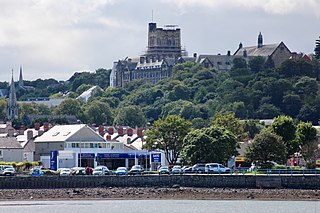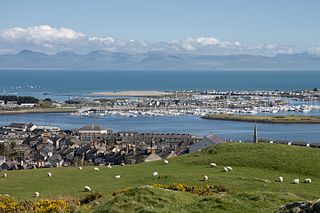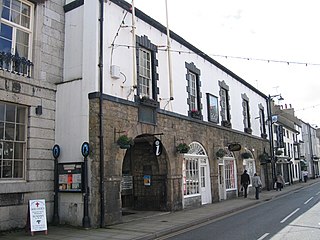
Caernarfon is a royal town, community and port in Gwynedd, Wales. It has a population of 9,852. It lies along the A487 road, on the eastern shore of the Menai Strait, opposite the island of Anglesey. The city of Bangor is 8.6 miles (13.8 km) to the north-east, while Snowdonia (Eryri) fringes Caernarfon to the east and south-east.

Gwynedd is a county in the north-west of Wales. It borders Anglesey across the Menai Strait to the north, Conwy, Denbighshire, and Powys to the east, Ceredigion over the Dyfi estuary to the south, and the Irish Sea to the west. The city of Bangor is the largest settlement, and the administrative centre is Caernarfon. The preserved county of Gwynedd, which is used for ceremonial purposes, includes the Isle of Anglesey.

Caernarfonshire, sometimes spelled Caernarvonshire or Carnarvonshire, was one of the thirteen historic counties of Wales, in the north-west of Wales.

Bangor is a cathedral city and community in Gwynedd, North Wales. It is the oldest town in Wales. Historically part of Caernarfonshire, the community had a population of 15,060 at the 2021 census, and the built up area had a population of 16,990. Landmarks include Bangor Cathedral, Bangor University and Garth Pier. The Britannia and Menai Suspension bridges connect the city to the Isle of Anglesey.

Pwllheli is a market town and community on the Llŷn Peninsula, in Gwynedd, north-west Wales. It had a population of 4,076 in 2011, which declined slightly to 3,947 in 2021; a large proportion (81%) were Welsh speaking. Pwllheli is the place where Plaid Cymru was founded. It is the birthplace of the Welsh poet Sir Albert Evans-Jones.

The Borough of Arfon was local government district with borough status from 1974 to 1996, being one of five districts in the county of Gwynedd, north-west Wales.

Segontium is a Roman fort on the outskirts of Caernarfon in Gwynedd, North Wales.

Caernarfon Castle is a medieval fortress in Gwynedd, north-west Wales. The first fortification on the site was a motte-and-bailey castle built in the late 11th century, which King Edward I of England began to replace with the current stone structure in 1283. The castle and town established by Edward acted as the administrative centre of north Wales, and as a result the defences were built on a grand scale. There was a deliberate link with Caernarfon's Roman past—nearby is the Roman fort of Segontium—and the castle's walls are reminiscent of the Walls of Constantinople.

County Hall is a former municipal facility at Castle Ditch in Caernarfon, Wales. The County Hall, which was the headquarters of Caernarfonshire County Council from 1889 to 1974, is a Grade I listed building.

Beaumaris Town Hall is a municipal building on Castle Street, in Beaumaris, Anglesey, Wales. The structure, which is the meeting place of Beaumaris Town Council, is a Grade II listed building.

Laugharne Town Hall is a municipal building in Market Street in Laugharne, Carmarthenshire, Wales. The structure, which is the meeting place of Laugharne Corporation, is a Grade II* listed building.

Bala Town Hall, known in the late 19th century as the County Hall, is a municipal building in Bala, Gwynedd, Wales. The structure, which is now used as a restaurant, is a Grade II listed building.

Tremadog Town Hall is a municipal building on Stryd Fawr, in Tremadog, Gwynedd, Wales. The structure, which was most recently used as a shop, is a Grade II* listed building.

The Old Market Hall is a municipal building in the Market Place, Blaenau Ffestiniog, Gwynedd, Wales. The structure, which also served as the Town Hall, is a Grade II listed building.

County Hall is a municipal building in Smithfield Street, Dolgellau, Gwynedd, Wales. The structure, which was the headquarters of Merionethshire County Council, is a Grade II* listed building.

Pwllheli Town Hall is a municipal building in Penlan Street, Pwllheli, Gwynedd, Wales. The structure, which now operates as an arts centre, is a Grade II listed building.

Crickhowell Market Hall, formerly Crickhowell Town Hall, is a municipal building in the High Street, Crickhowell, Powys, Wales. The structure, which accommodates market stalls on the ground floor and a café on the first floor, is a Grade II* listed building.

Kidwelly Town Hall is a municipal building in Lady Street, Kidwelly, Carmarthenshire, Wales. The structure, which was last used as a public library but is currently vacant, is a Grade II listed building.

Cawdor Hall, also known as Newcastle Emlyn Town Hall, is a municipal building in the Market Square, Newcastle Emlyn, Carmarthenshire, Wales. The structure, which is currently used as a theatre, is a Grade II listed building.

The Old Town Hall is a municipal building located on the High Street in Aberdare in Rhondda Cynon Taf in Wales. The structure, which is currently used as a coffee shop, is a Grade II listed building.





















